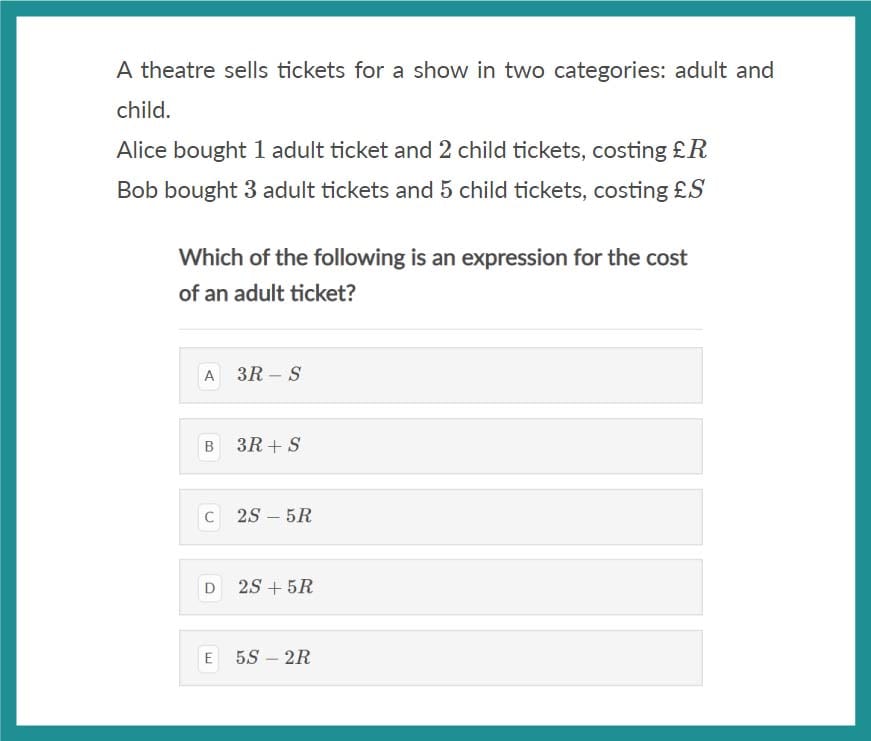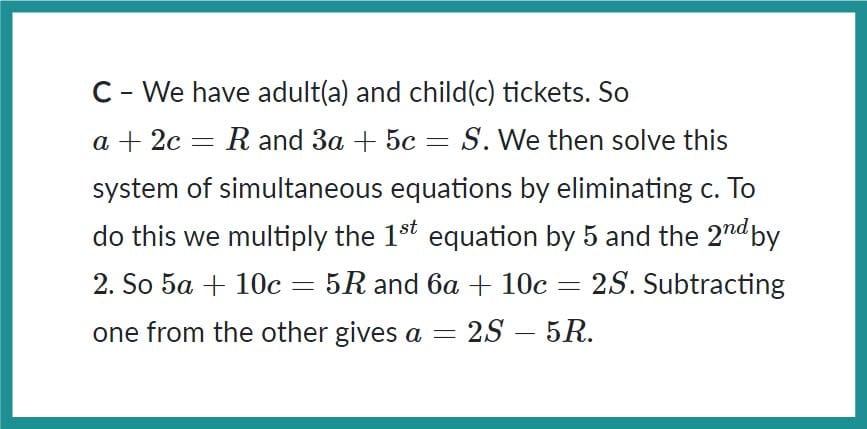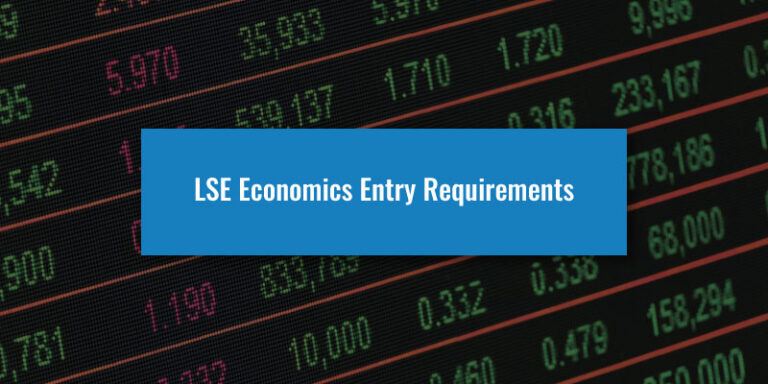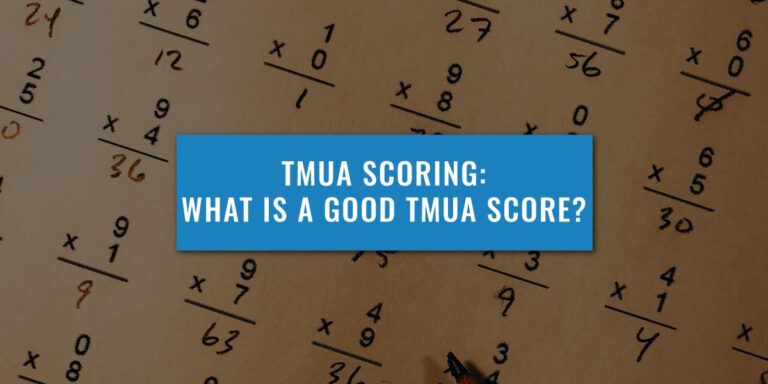The ECAA is no longer being used for Cambridge Economics. The TMUA is used instead for 2022 Economics Applicants.
ECAA Section 1A tests Maths. Students tend not to struggle too much with this section – but this does not make preparing for it any less important.
Section 1 (A and B) is a 60-minute section with 40 questions so students have just over 2 minutes for each question. Students often lose the most marks by wasting their minimal time on tricky questions. You have an equal amount of time for Section 1A and Section 1B (although you can use the time how you wish, the examiners strongly recommend you spend equal parts on both).
In this article, we have included some section 1A tips and the syllabus to help you get started with your preparation.
Before we begin, try this practice question (explained answer at the end):
Get access to hundreds of TMUA questions, all with fully worked solutions written by Oxbridge experts through the UniAdmissions Economics Premium Programme.
Starting with the simple tips
- Read the entire question!
Since the time pressure of the exam is quite harsh, students can often disregard this basic tip. Make sure you read the entire question and understand what it is asking of you.
- Use the options
Using the options effectively allows you to pick out key information from the question and quickly disregard some options. This is the beauty of a multiple-choice test and you should use it to your advantage.
- Don’t be afraid to skip and come back to questions
You should do a lot of practice beforehand to ensure you know the timing of the test very well before employing this tip. You can skip questions that will “waste” your time. If a question is difficult and it’s taking you longer than it should do, skip it, make a mental note and come back to it at the end.
Mental maths
It may be a while since you’ve had to do any significant mental maths, however, it’s worth brushing up on these skills for the ECAA. You cannot use a calculator for any sections of the ECAA so being able to quickly work out figures in your head will save you a lot of time.
Then Onto The Bulk Of the Specification
The next step is to look at the entire Maths syllabus. This looks like a lot, but once you realise that most of the content in Section 1A is relatively straightforward, it doesn’t seem quite so bad.
Instead of a revision list, consider this specification as more of a checklist to tick off as you read it. Most of these topics will be familiar to you and are unlikely to need much focus. If there are any that you aren’t 100% confident with, brush up on that particular section to ensure you’re prepared for the ECAA.
| M1.1 | Use standard units of mass, length, time, money and other measures. Use compound units such as speed, rates of pay, unit pricing, density and pressure, including using decimal quantities where appropriate. |
| M1.2 | Change freely between related standard units (e.g. time, length, area, volume/capacity, mass) and compound units (e.g. speed, rates of pay, prices, density, pressure) in numerical and algebraic contexts. |
| M2.1 | Order positive and negative integers, decimals and fractions. Understand and use the symbols: = , ≠ , < , > , ≤ , ≥ . |
| M2.2 | Apply the four operations (addition, subtraction, multiplication and division) to integers, decimals, simple fractions (proper and improper) and mixed numbers – any of which could be positive and negative. Understand and use place value. |
| M2.3 | Use the concepts and vocabulary of prime numbers, factors (divisors), multiples, common factors, common multiples, highest common factor, lowest common multiple, and prime factorisation (including use of product notation and the unique factorisation theorem). |
| M2.4 | Recognise and use relationships between operations, including inverse operations. Use cancellation to simplify calculations and expressions. Understand and use the convention for priority of operations, including brackets, powers, roots and reciprocals. |
| M2.5 | Apply systematic listing strategies. (For instance, if there are m ways of doing one task and for each of these tasks there are n ways of doing another task, then the total number of ways the two tasks can be done in order is m× n ways.) |
| M2.6 | Use and understand the terms: square, positive and negative square root, cube and cube root. |
| M2.7 | Use index laws to simplify numerical expressions, and for multiplication and division of integer, fractional and negative powers. |
| M2.8 | Interpret, order and calculate with numbers written in standard index form (standard form); numbers are written in standard form as a × 10n, where 1 ≤ a < 10 and n is an integer. |
| M2.9 | Convert between terminating decimals, percentages and fractions. Convert between recurring decimals and their corresponding fractions |
| M2.10 | Use fractions, decimals and percentages interchangeably in calculations. Understand equivalent fractions. |
| M2.11 | Calculate exactly with fractions, surds and multiples of π. Simplify surd expressions involving squares, e.g. √12 = √4 x 3 = √4√3 = 2√3, and rationalise denominators; for example, candidates could be asked to rationalise expressions such as: 3 / √7, 5 / 3 + 2√5, 7 / 2 – √3, 3 / √5 – √2. |
| M2.12 | Calculate with upper and lower bounds, and use in contextual problems. |
| M2.13 | Round numbers and measures to an appropriate degree of accuracy, e.g. to a specified number of decimal places or significant figures. Use inequality notation to specify simple error intervals due to truncation or rounding. |
| M2.14 | Use approximation to produce estimates of calculations, including expressions involving π or surds. |
| M3.1 | Understand and use scale factors, scale diagrams and maps. |
| M3.2 | Express a quantity as a fraction of another, where the fraction is less than 1 or greater than 1. |
| M3.3 | Understand and use ratio notation. |
| M3.4 | Divide a given quantity into two (or more) parts in a given part:part ratio. Express the division of a quantity into two parts as a ratio. |
| M3.5 | Apply ratio to real contexts and problems, such as those involving conversion, comparison, scaling, mixing and concentrations. Express a multiplicative relationship between two quantities as a ratio or a fraction. |
| M3.6 | Understand and use proportion. Relate ratios to fractions and to linear functions. |
| M3.7 | Identify and work with fractions in ratio problems. |
| M3.8 | Define percentage as ‘number of parts per hundred’. Interpret percentages and percentage changes as a fraction or a decimal, and interpret these multiplicatively. Express one quantity as a percentage of another. Compare two quantities using percentages. Work with percentages greater than 100%. Solve problems involving percentage change, including percentage increase/decrease, original value problems and simple interest calculations. |
| M3.9 | Understand and use direct and inverse proportion, including algebraic representations. Recognise and interpret graphs that illustrate direct and inverse proportion. Set up, use and interpret equations to solve problems involving direct and inverse proportion (including questions involving integer and fractional powers). Understand that x is inversely proportional to y is equivalent to x is proportional to 1 / y. |
| M3.10 | Compare lengths, areas and volumes using ratio notation. Understand and make links to similarity (including trigonometric ratios) and scale factors |
| M3.11 | Set up, solve and interpret the answers in growth and decay problems, including compound interest, and work with general iterative processes. |
| M4.1 | Understand, use and interpret algebraic notation; for instance: ab in place of a×b ; 3y in place of y+y+y and 3 × y ; a2 in place of a×a ; a3 in place of a×a×a ; a2b in place of a×a×b ; a / b in place of a ÷ b |
| M4.2 | Use index laws in algebra for multiplication and division of integer, fractional, and negative powers. |
| M4.3 | Substitute numerical values into formulae and expressions, including scientific formulae. Understand and use the concepts and vocabulary: expressions, equations, formulae, identities, inequalities, terms and factors. |
| M4.4 | Collect like terms, multiply a single term over a bracket, take out common factors, and expand products of two or more binomials. |
| M4.5 | Factorise quadratic expressions of the form x2 + bx +c, including the difference of two squares. Factorise quadratic expressions of the form ax2 + bx +c, including the difference of two squares. |
| M4.6 | Simplify expressions involving sums, products and powers, including the laws of indices. Simplify rational expressions by cancelling, or factorising and cancelling. Use the four rules on algebraic rational expressions. |
| M4.7 | Rearrange formulae to change the subject. |
| M4.8 | Understand the difference between an equation and an identity. Argue mathematically to show that algebraic expressions are equivalent |
| M4.9 | Work with coordinates in all four quadrants. |
| M4.10 | Identify and interpret gradients and intercepts of linear functions ( y = mx + c ) graphically and algebraically. Identify pairs of parallel lines and identify pairs of perpendicular lines, including the relationships between gradients. Find the equation of the line through two given points, or through one point with a given gradient. |
| M4.11 | Identify and interpret roots, intercepts and turning points of quadratic functions graphically. Deduce roots algebraically, and turning points by completing the square. |
| M4.12 | Recognise, sketch and interpret graphs of: a. linear functions b. quadratic functions c. simple cubic functions d. the reciprocal function: y = x / 1 with x≠0 e. the exponential function: y = kx for positive values of k f. trigonometric functions (with arguments in degrees): y = sin x, y = cos x, y = tan x for angles of any size |
| M4.13 | Interpret graphs (including reciprocal graphs and exponential graphs) and graphs of non-standard functions in real contexts to find approximate solutions to problems, such as simple kinematic problems involving distance, speed and acceleration. |
| M4.14 | Calculate or estimate gradients of graphs and areas under graphs (including quadratic and other non-linear graphs), and interpret results in cases such as distance–time graphs, speed–time graphs and graphs in financial contexts. |
| M4.15 | Set up and solve, both algebraically and graphically, simple equations including simultaneous equations involving two unknowns; this may include one linear and one quadratic equation. Solve two simultaneous equations in two variables (linear/linear or linear/quadratic) algebraically. Find approximate solutions using a graph. Translate simple situations or procedures into algebraic expressions or formulae; for example, derive an equation (or two simultaneous equations), solve the equation(s) and interpret the solution. |
| M4.16 | Solve quadratic equations (including those that require rearrangement) algebraically by factorising, by completing the square, and by using the quadratic formula. Know the quadratic formula: x = – b ± √b2 – 4ac / 2a Find approximate solutions of quadratic equations using a graph. |
| M4.17 | Solve linear inequalities in one or two variables. Represent the solution set on a number line, or on a graph, or in words. |
| M4.18 | Generate terms of a sequence using term-to-term or position-to-term rules. |
| M4.19 | Deduce expressions to calculate the nth term of linear or quadratic sequences. |
| M5.1 | Use conventional terms and notation: points, lines, line segments, vertices, edges, planes, parallel lines, perpendicular lines, right angles, subtended angles, polygons, regular polygons and polygons with reflection and/or rotational symmetries. |
| M5.2 | Recall and use the properties of angles at a point, angles on a straight line, perpendicular lines and opposite angles at a vertex. Understand and use the angle properties of parallel lines, intersecting lines, triangles and quadrilaterals. Calculate and use the sum of the interior angles, and the sum of the exterior angles, of polygons. |
| M5.3 | Derive and apply the properties and definitions of special types of quadrilaterals, including square, rectangle, parallelogram, trapezium, kite and rhombus. Derive and apply the properties and definitions of various types of triangle and other plane figures using appropriate language. |
| M5.4 | Understand and use the basic congruence criteria for triangles (SSS, SAS, ASA, RHS). |
| M5.5 | Apply angle facts, triangle congruence, similarity, and properties of quadrilaterals to results about angles and sides. |
| M5.6 | Identify, describe and construct congruent and similar shapes, including on coordinate axes, by considering rotation, reflection, translation and enlargement (including fractional and negative scale factors). Describe the changes and invariance achieved by combinations of rotations, reflections and translations. Describe translations as 2-dimensional vectors. |
| M5.7 | Know and use the formula for Pythagoras’ theorem: a2 + b2 = c2 Use Pythagoras’ theorem in both 2 and 3 dimensions. |
| M5.8 | Identify and use conventional circle terms: centre, radius, chord, diameter, circumference, tangent, arc, sector and segment (including the use of the terms minor and major for arcs, sectors and segments). |
| M5.9 | Apply the standard circle theorems concerning angles, radii, tangents and chords, and use them to prove related results: a. angle subtended at the centre is twice the angle subtended at the circumference b. angle in a semicircle is 90° c. angles in the same segment are equal d. angle between a tangent and a chord (alternate segment theorem) e. angle between a radius and a tangent is 90° f. properties of cyclic quadrilaterals |
| M5.10 | Solve geometrical problems on 2-dimensional coordinate axes. |
| M5.11 | Know the terminology faces, surfaces, edges and vertices when applied to cubes, cuboids, prisms, cylinders, pyramids, cones, spheres and hemispheres. |
| M5.12 | Interpret plans and elevations of 3-dimensional shapes. |
| M5.13 | Use and interpret maps and scale drawings. Understand and use three-figure bearings. |
| M5.14 | Know and apply formulae to calculate: a. the area of triangles, parallelograms, trapezia b. the volume of cuboids and other right prisms. |
| M5.15 | Know the formulae: a. circumference of a circle = 2πr = πd b. area of a circle = πr2 c. volume of a right circular cylinder = πr2h Formulae relating to spheres, pyramids and cones will be given if needed. Use formulae to calculate: a. perimeters of 2-dimensional shapes, including circles b. areas of circles and composite shapes c. surface area and volume of spheres, pyramids, cones and composite solids |
| M5.16 | Calculate arc lengths, angles and areas of sectors of circles. |
| M5.17 | Apply the concepts of congruence and similarity in simple figures, including the relationships between lengths, areas and volumes. |
| M5.18 | Know and use the trigonometric ratios: sinθ = opposite / hypotenuse cosθ = adjacent / hypotenuse tanθ = opposite / adjacent Apply these to find angles and lengths in right-angled triangles and, where possible, general triangles in 2- and 3-dimensional figures. Know the exact values of sinθ and cosθ for θ = 0°, 30°, 45°, 60°, 90°. Know the exact values of tanθ for θ = 0°, 30°, 45°, 60°. Candidates are not expected to recall or use the sine or cosine rules. |
| M5.19 | Apply addition and subtraction of vectors, multiplication of vectors by a scalar, and diagrammatic and column representations of vectors. Use vectors to construct geometric arguments and proofs. |
| M6.1 | Interpret and construct tables, charts and diagrams, including: a. two-way tables, frequency tables, bar charts, pie charts and pictograms for categorical data b. vertical line charts for ungrouped discrete numerical data c. tables and line graphs for time series data Know the appropriate use of each of these representations. |
| M6.2 | Interpret and construct diagrams for grouped discrete data and continuous data: a. histograms with equal and unequal class intervals b. cumulative frequency graphs Know the appropriate use of each of these diagrams. Understand and use the term frequency density. |
| M6.3 | Calculate the mean, mode, median and range for ungrouped data. Find the modal class; calculate estimates of the range, mean and median for grouped data, and understand why these are estimates. Describe a population using statistics. Make simple comparisons. Compare data sets using like-for-like summary values. Understand the advantages and disadvantages of summary values. Calculate estimates of mean, median, mode, range, quartiles and interquartile range from graphical representation of grouped data. Use the median and interquartile range to compare distributions. |
| M6.4 | Use and interpret scatter graphs of bivariate data. Recognise correlation, and know that it does not indicate causation. Draw estimated lines of best fit. Interpolate and extrapolate apparent trends whilst knowing the dangers of so doing. |
| M6.1 | Analyse the frequency of outcomes of probability experiments using tables and frequency trees. |
| M6.2 | Apply ideas of randomness, fairness and equally likely events to calculate expected outcomes of multiple future experiments. Understand that if an experiment is repeated, the outcome may be different. |
| M6.3 | Relate relative expected frequencies to theoretical probability, using appropriate language and the ‘0 to 1’ probability scale. |
| M6.4 | Apply the property that the probabilities of an exhaustive set of outcomes sum to one. Apply the property that the probabilities of an exhaustive set of mutually exclusive events sum to one. |
| M6.5 | Enumerate sets and combinations of sets systematically, using tables, grids, Venn diagrams and tree diagrams. Candidates are not expected to know formal set theory notation. |
| M6.6 | Construct theoretical possibility spaces for single and combined experiments with equally likely outcomes, and use these to calculate theoretical probabilities. |
| M6.7 | Know when to add or multiply two probabilities, and understand conditional probability. Calculate and interpret conditional probabilities through representation using expected frequencies with two-way tables, tree diagrams and Venn diagrams. Understand the use of tree diagrams to represent outcomes of combined events: a. when the probabilities are independent of the previous outcome b. when the probabilities are dependent on the previous outcome. |
Whatever your exam board, you should have covered all of these topics at some point during your GCSEs and A-levels.
How is Section 1 of the ECAA scored?
In Section 1, each correct answer scores 1 mark and is scored on a scale of 1.0 to 9.0. No marks are deducted for incorrect answers. Results for Part A and Part B are reported separately.
Most students score between 3.0-5.0 on Section 1A and the strongest candidates score over 6.0. This is the same with Section 1B but you should aim for 6.5 to stand out from other applicants.
ECAA Section 1A worked example
Example ECAA Section 1A Question:
Example ECAA Section 1A Answer:
Secure your Cambridge Economics offer with our specialist support.
At UniAdmissions, we are experts at maximising your chances of gaining a place to study Economics at Cambridge. We provide TMUA specialised support to help you craft the perfect application.
Our Oxbridge Economics Premium Programme gives you everything you need to ultimately gain your dream offer.









